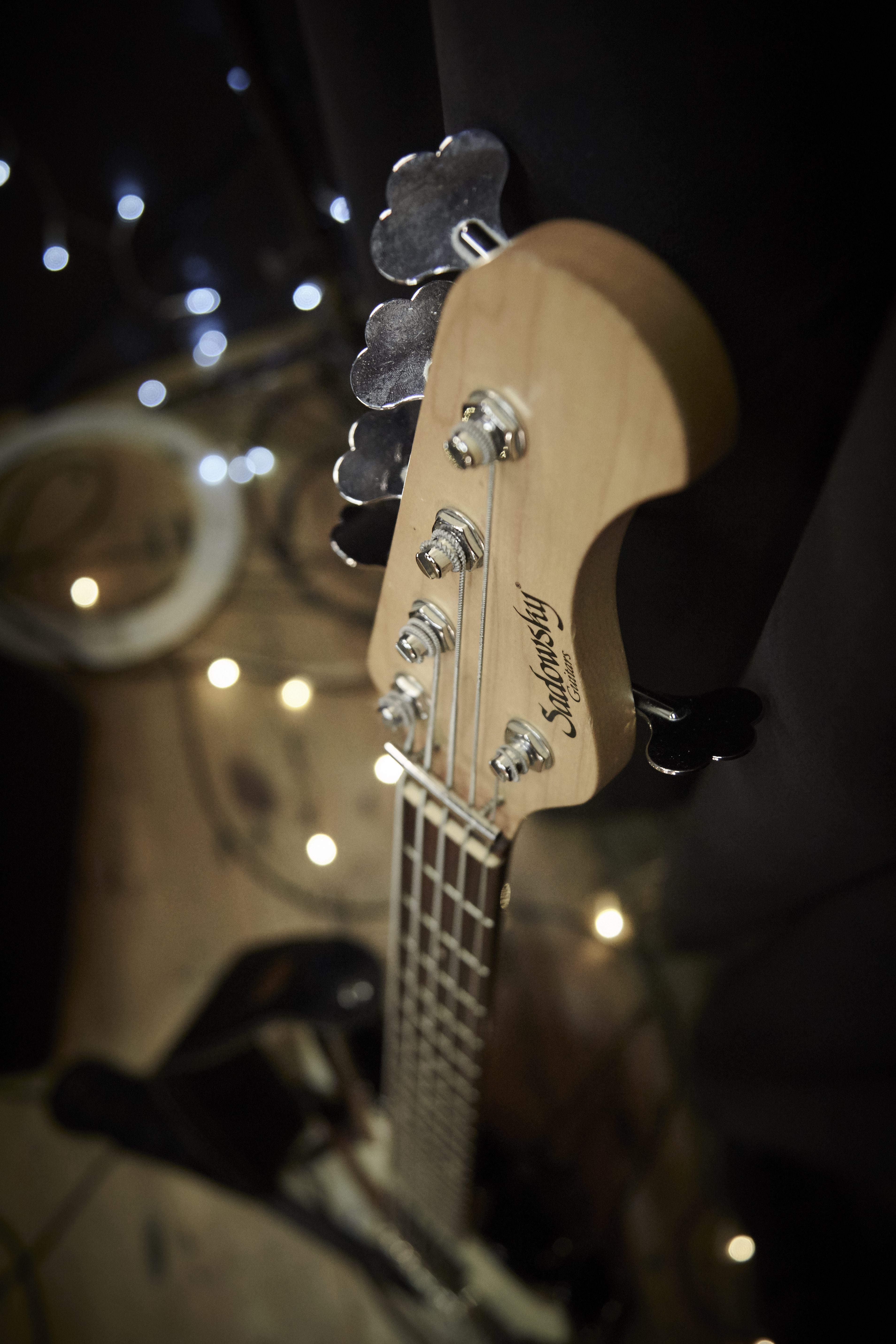Starting out on 5 String Bass can seem pretty daunting, especially if you’ve only ever played 4 String. But here’s the thing – learning a new instrument doesn’t have to be scary! With dedication, commitment, and practice you’ll be rocking riffs in no time.
In this article, we’re going to look at what makes 5 String Bass more challenging than a 4 String, and how you can conquer that with the right approach. So don’t worry – by the end of this article you’ll know exactly how to start your 5 String Bass journey the right way!
Free 5 String Bass Chord Chart PDF
Before we start, take a moment to download 15 chord shapes in this free PDF which you can use to expand your knowledge of the 5-string bass.
These shapes range from simple triads – which have a root note, third and fifth – all the way up to more complex chords with sevenths and some extensions.
There’s also a little bit of chord voicing technique included which teaches you how to deal with low notes in chords more effectively.
It’s always the low notes that are the most problematic!
Are 5 string basses good for beginners?
As a beginner bass player, you might be wondering if a 5 string bass is a good option for you. The answer is that it depends on what you’re looking for.
A 5 string bass can give you more range and options when playing, but it can also be more difficult to learn on.
If you’re just starting out, you might want to stick with a 4 string bass until you get more comfortable with the instrument.
But if you’re set on getting a 5 string bass, go for it! Just be prepared to put in some extra practice to master those extra strings.
5 String Bass guitar scales
Even though a 5 string bass has an extra string, the pattern of the scale stays the same. The only difference is that the 5 string bass has a larger range because of that extra string.
If you know how to play a 4 string bass, then you can easily transition to playing a 5 string bass.
The logic of the patterns is just the same because the 5 string bass is still tuned in 4ths if it follows standard tuning.
This means the major scale pattern on a 5 string is the same as the major scale pattern on a four string.
And just as with the major scale, all other patterns like the minor scale, pentatonic and blues scales are also the same.
Tuning A 5 String
The standard tuning for a 5 string bass guitar is B-E-A-D-G.
The lowest string of the bass is tuned to a B (this is the thickest string on the 5 string) and this is why it’s called the low B string.
This string is the extra string that’s added and is what gives the 5 string its extended low range.
The E string is next and you could think of this string as being where the standard tuning part of the 5 string bass begins.
Then there’s the A string, D string and G string.
Floating thumb technique
The floating thumb technique is the technique a 5 string bass guitar player will use to mute the strings they are not playing.
The idea is that you should rest your thumb on the string below the one you are playing with the outer edge of your thumb resting gently against all the other lower strings.
This stops them all ringing out in sympathetic vibration and ensures you have a great muting technique for 5 string bass.
Five String Pro #1 – Extra String Means Extended Range
At first, the 5 string bass may not seem all that different from the 4 string bass. However, the extra low B string on the 5 string bass adds a whole new range of notes for the player to use.
This extended range can be extremely beneficial for certain genres of music, such as metal or jazz. In metal music, the low B string can be used for those extreme, guttural growls that are so characteristic of the genre.
In jazz, the extended range can be used for more complex melodies and chord progressions. So if you’re looking to add a bit more versatility to your playing, consider investing in a 5 string bass.
Five String Pro #2 – You don’t have to re-tune
Because a 5 string bass has an extended range, this means it’s easy to get a low note in typically less “bass friendly” keys such as Eb, Db, B or low D without having to retune.
Many bass players are used to having to retune the bottom string of a 4 string (the E string) but with a 5 string there’s no need.
Plus, all your scale shapes will have the same pattern as always which isn’t the case when you retune.
Five String Pro #3 – More Note Coverage
If you’re looking for a bass that gives you a greater coverage of notes on the neck, then a 5 string bass is a great option.
With the extra string, you can explore a wider range of notes and create more interesting bass lines.
The downside is that 5 string basses can be more expensive and difficult to find, but if you’re serious about expanding your musical horizons, they’re definitely worth considering.
Five String Con #1 – Muting the low B String
One of the biggest difficulties of playing a 5 string bass guitar is muting the B string.
It goes without saying that more strings means more strings that need to be muted. Having more strings also mean a greater neck width which many find hard when they start learning.
It’s important to say that this isn’t a reason to avoid a 5 string altogether. In fact, there are plenty of techniques you can learn to help you mute effectively such as the floating thumb technique.
If you want to learn to mute then learn the floating thumb technique and with a bit of patience and hard work this problem will be solved.
Five String Con #2 – Playability
The bigger neck width does affect playability. Many bassists find that they have to bend their wrists a little more and this can lead to muscle tension or even an injury.
And when you factor in a potentially wider string spacing means that your fingers will have greater distances to travel and all of this means that a 5 string is potentially less playable.
There are some ways round this, however.
You could look at models that have a narrower string spacing or a shorter scale which would help compensate this issue.
They still work as normal, they have standard tuning and they’re still great for bass lines, riffs or any other aspect of bass playing.
Brands like Spector are well worth a look if you’re curious.
Five String Con #3 – Heavier Instruments
As we’ve seen, the extra B string means a wider neck. A wider neck means a bigger body to support it and all of this adds up to a heavier bass guitar.
Is a heavier bass guitar worth it for the sake of a low B?
This one is really up to you.
You can find some lighter models with 5 strings but these are typically made from more modern materials.
So if you want the sound that comes from an older tonewood then playing one of these modern models might not be your thing.
Beginner 5-string bass songs
Now that we’ve taken a close look at the 5 string bass guitar, let’s take a quick look at some songs you could learn to really make use of that extra B string.
Below are a few tips on songs you could learn to get the best out of your new instrument.
By no means is this a complete list so feel free to branch out and learn other songs that also inspire you.
Superstition – Stevie Wonder
“Superstition” by Stevie Wonder was released in 1972 and was taken from his sixteenth studio album, Talking Book.
The hit single became the first ever pop song to feature the clavinet, a keyboard instrument with the remarkable sound capability of producing electronic sounds similar to that of a guitar.
With its catchy tune and intricate rhythm, “Superstition” helped usher in the funk music movement during the 1970s. Stevie Wonder’s pioneering mix of soulful lyrics and progressive instrumentals made it an instant classic around the world.
To this day, it’s considered one of pop music’s most iconic tunes, influencing musicians long after its release over 40 years ago.
Funky Monks – Red Hot Chili Peppers
Funky Monks is the seventh studio album by the Red Hot Chili Peppers. The album was released on November 23, 1991, by Warner Bros. Records.
The album was produced by Rick Rubin and features musical contributions from John Frusciante and Chad Smith. Funky Monks peaked at number three on the Billboard 200 and was certified platinum by the Recording Industry Association of America (RIAA).
The album received positive reviews from critics, who praised its musical style and Rubin’s production.
Which is better for beginners?
As a teacher, I would say that the verdict of 4 string vs 5 string bass for beginners becomes quite tricky. The primary difference between them is the presence of an extra string in 5-string bass guitars, and it can be more challenging to learn.
On the other hand, 5-string bass gives you more flexibility when you play and provides room to explore different things. Therefore, if a beginner is excited to branch out of traditional playing styles and open themselves up to improvement in technique, then they may consider learning on a 5-string bass as it offers greater versatility and a richer sound.
However, 4-string instruments are still perfectly suited for absolute starters who want to get comfortable with their instrument.
All in all, there isn’t one clear answer here – the best mentor would be the exploration of both options until one finds a favorite for themselves!





Leave a Reply